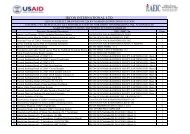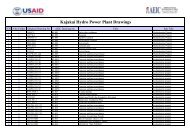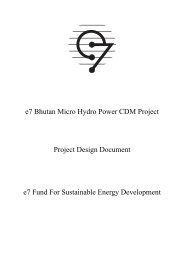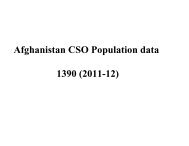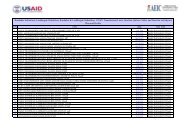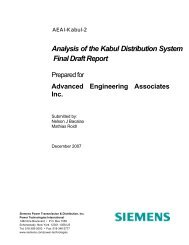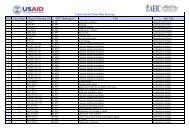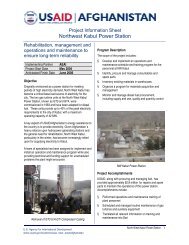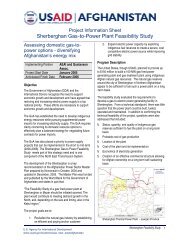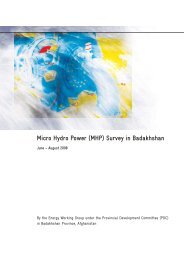prioritization and implementation plan - Cooperazione Italiana allo ...
prioritization and implementation plan - Cooperazione Italiana allo ...
prioritization and implementation plan - Cooperazione Italiana allo ...
Create successful ePaper yourself
Turn your PDF publications into a flip-book with our unique Google optimized e-Paper software.
FACILITATING HUMAN RESOURCE DEVELOPMENT<br />
The Human Resource Development (HRD) Cluster<br />
Members: Minister of Education (MoE), Ministry<br />
of Higher Education (MoHE), Ministry of<br />
Women’s Affairs (MoWA), Ministry of Labor,<br />
Social Affairs, Martyrs <strong>and</strong> Disabled<br />
(MoLSAMD), <strong>and</strong> Ministry of Public Health<br />
(MoPH).<br />
Introduction<br />
Human resources are the backbone of a nation’s<br />
economy, reflecting national capacity to supply<br />
needed skills for economic growth <strong>and</strong><br />
productivity. Without a strong, equitable, <strong>and</strong><br />
appropriate approach to human resource<br />
development, sustainable economic growth<br />
remains elusive. Education <strong>and</strong> skills development<br />
are the vehicles by which human resource<br />
development occurs.<br />
Despite significant improvements over the past<br />
nine years, human resource development in<br />
Afghanistan continues to face a number of<br />
challenges. One of the most significant is the skills<br />
gap between labor supply <strong>and</strong> market dem<strong>and</strong>s.<br />
Despite a wide range of educational initiatives,<br />
including formal <strong>and</strong> informal education, literacy<br />
programs, technical <strong>and</strong> vocational skills-building<br />
programs, neither recent graduates nor the labor<br />
force as a whole are meeting the skill dem<strong>and</strong>s of<br />
the market. According to recent estimates, 35% of<br />
Afghans are not employed (2008 est.). This has<br />
perpetuated a continued reliance on foreign aid <strong>and</strong><br />
dependency on foreign labor.<br />
Further challenges to human resource development<br />
pertain to equity, quality <strong>and</strong> access to education<br />
initiatives, issues that are particularly acute for<br />
girls <strong>and</strong> women. Gender disparities exist across all<br />
sectors, but are most evident in education <strong>and</strong><br />
health, where few service providers <strong>and</strong> service<br />
beneficiaries are female. Of the estimated 42% of<br />
Afghanistan’s school-aged population which do<br />
not have access to basic education, the majority<br />
(approximately 70%) are girls. Educational gender<br />
disparities are even greater in the poorest, less<br />
secure, <strong>and</strong> remote areas.<br />
The issues of access, relevance, <strong>and</strong> quality also<br />
extend to higher education where opportunities for<br />
enrollment are severely constrained <strong>and</strong> formal<br />
educational offerings are few. Not surprisingly,<br />
universities are unable to provide the quality or<br />
quantity of professionals needed for the labor<br />
market, particularly in the management <strong>and</strong><br />
technical fields where dem<strong>and</strong>s are critical.<br />
Finally, the energy, ideas, initiatives <strong>and</strong> market<br />
savvy of the private sector remain largely untapped<br />
in the development of labor-driven human<br />
resources, which in part, contributes to the wide<br />
skills gap <strong>and</strong> the high unemployment rate.<br />
Needed Response<br />
The Human Resource Development (HRD) Cluster<br />
was established with the objective of producing<br />
quality human resources <strong>and</strong> of promoting <strong>and</strong><br />
sustaining economic development, which will, in<br />
turn, foster stability <strong>and</strong> security for its citizens.<br />
The HRD Cluster provides an inter-ministerial<br />
forum for instituting systematic improvements <strong>and</strong><br />
is working at the policy level to find effective <strong>and</strong><br />
creative ways to enable Afghans – both men <strong>and</strong><br />
women – to more fully contribute to society, both<br />
socially <strong>and</strong> economically. The Cluster is<br />
organized around the shared belief that the<br />
government, private sector, <strong>and</strong> civil society<br />
should work together to form a coherent approach<br />
to the development of human resource capacity to<br />
maximize benefits for all Afghan citizens. In<br />
response to the identified challenges <strong>and</strong> needs,<br />
five main areas of focus for National Priority<br />
Programs in the HRD Cluster were identified:<br />
1. Facilitation of Sustainable Decent Work<br />
Through Skills-Development <strong>and</strong> Market-Friendly<br />
Labor Regulation Program aims to diminish the<br />
skills gap by providing Afghan youth <strong>and</strong> young<br />
adults technical <strong>and</strong> vocational education which is<br />
high quality, market-relevant, dem<strong>and</strong>-driven <strong>and</strong><br />
certified. For those who have been left behind from<br />
the formal educational system, this program<br />
provides literacy training in combination with the<br />
development of marketable skills, thus enhancing<br />
employability of a broad spectrum of the<br />
population.<br />
32





